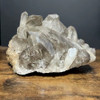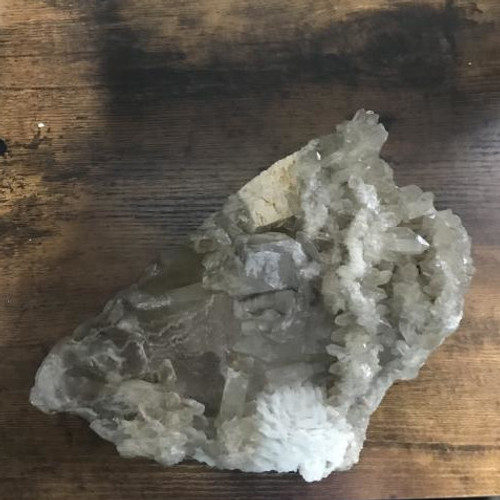Product Description
Quartz Cluster Phantoms w/ Cleavelandite, Hematite & Smoky Quartz 3392grams
Mineral Information:
Quartz is a mineral that is composed of silicon and oxygen atoms in a continuous framework of SiO4 silicon-oxygen tetrahedra, which gives it a unique crystalline structure. It is one of the most abundant minerals in the Earth's crust and can be found in a wide range of environments, including igneous, metamorphic, and sedimentary rocks.
Quartz is known for its wide variety of colors and patterns, which are determined by the presence of trace elements or structural defects within the crystal. Some of the most common varieties of quartz include clear quartz, rose quartz, amethyst, smoky quartz, and citrine.
Quartz is also valued for its physical and chemical properties, including its hardness (7 on the Mohs scale), durability, and its ability to conduct electricity. It is widely used in a variety of industrial applications, including electronics, optical equipment, and building materials. Additionally, quartz has been used for centuries in spiritual practices and alternative medicine, due to its believed ability to enhance energy, promote healing, and enhance spiritual development.
Metaphysical Meaning:
Quartz is widely used for amplification. it is believed to amplify the energy of other crystals as well as the energy of the person using it. Quartz is said to enhance clarity and focus and is thought to enhance focus and concentration. Quartz is also said to have powerful healing abilities and is used in crystal healing practices to help balance the body's energy systems and promote health and wellbeing. Quartz is also used for protection and spiritual development.
Cleavelandite is useful in balancing emotional wounds, abandonment, betrayal, and rejection. It helps you accept others for who they are and to see the truth.
Mineral Care:
Quartz is a mineral that is relatively hard and durable compared to many other minerals. It has a hardness of 7 on the Mohs scale, which means that it is resistant to scratching and chipping. However, despite its hardness, quartz is still a brittle material and can be susceptible to fracturing or shattering if subjected to extreme force or pressure.
The fragility of quartz can depend on a number of factors, including the size and shape of the crystal, the presence of structural defects or inclusions within the crystal, and the environmental conditions to which it is exposed. Large quartz crystals, for example, may be more susceptible to breaking than smaller ones, particularly if they have irregular shapes or have been subjected to stresses over time.
In addition, some natural quartz crystals may have internal fractures or inclusions that can affect their overall strength and durability. These types of imperfections may weaken the crystal and make it more prone to breaking or shattering under stress.
Overall, while quartz is a relatively hard and durable mineral, it should still be handled with care to avoid dropping or impacting it on hard surfaces, which can cause damage. It is also important to protect quartz from high temperatures, as extreme heat can cause cracking or discoloration.
Disclaimer:
No information here is intended to diagnose, treat or cure ailments or afflictions of any kind. One should always consult a medical professional if a serious issue presents itself.










